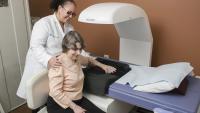Bone Density/DEXA

Make an Appointment
Request an appointment by phone or online. View our locations.
Bone Densitometry Provides Early Diagnosis of Osteoporosis
Bone densitometry is an important tool in the detection and treatment of osteoporosis. The most advanced form of bone densitometry, DEXA (dual energy X-ray absorptiometry), is a non-invasive and painless X-ray test of the spine, hip, and arm bones that gives doctors precise information about the amount of calcium in the bones.
Bone density testing is recommended for:
- Post-menopausal woman who are not taking estrogen
- People with a personal or maternal history of hip fracture or smoking
- Men with clinical conditions linked to bone loss
- People taking corticosteroids, certain anti-seizure medications, or high-dose thyroid replacement drugs
- Those with type 1 diabetes, liver or kidney disease, or a family history of osteoporosis
- People with a thyroid or parathyroid condition
- Those who have had a fracture following only mild trauma
At Columbia Radiology, we provide state-of-the-art bone densitometry in a convenient outpatient settings. Our Hologic Dual Energy X-ray (DEXA) Densitometer is an advanced way to diagnose osteoporosis and other bone demineralization conditions. Osteoporosis is preventable and treatable, and early detection is the best way to protect yourself from its potentially debilitating effects. With the DEXA test, we can determine your risk and take measures to reduce that risk safely and easily.
How do I prepare for the test?
No special preparation is necessary before you have a bone densitometry test.
What will happen during the test?
During the test the X-ray technologist will ask you to lie on an examination table for a few minutes. To obtain an image of your spine the technologist will place your legs on a padded box to position your pelvis and lower spine on the table. To image your hip, the technologist will place your foot in a brace that rotates the hip inward. The detector will then pass slowly over the area to be examined, and will transmit the images to a computer. The entire procedure takes from 10 to 20 minutes.
Are there any risks?
Bone density is a simple, safe, non-invasive, and painless scan. The amount of radiation you are exposed to during a DEXA scan is a fraction of that from a standard X-ray.
After the test
After the exam you can immediately resume your normal activities. A radiologist will analyze the DEXA images and will share the results with the doctor who requested the exam. Your doctor will then discuss the results with you.
How to Access Your Images
You can view, download, or share your exams through your Connect patient portal.
Once you are logged in, select “View Radiology Images” from the menu. A new web browser window will open to display a list of your exams.

